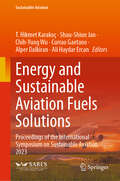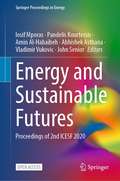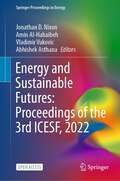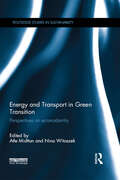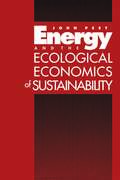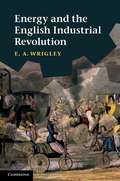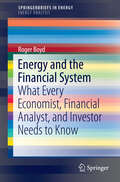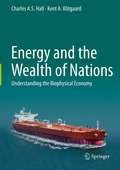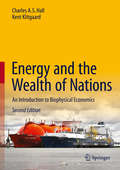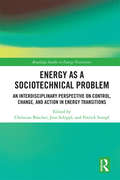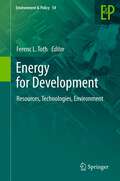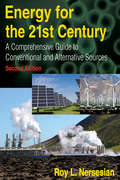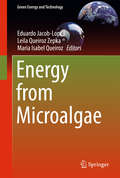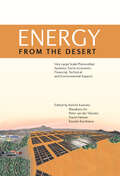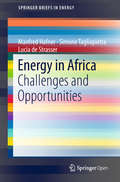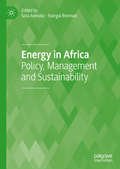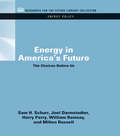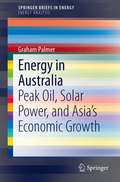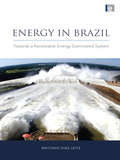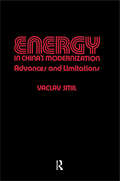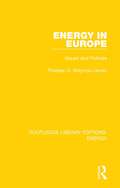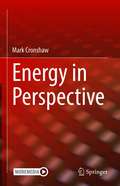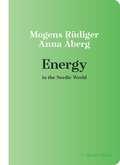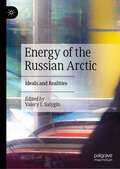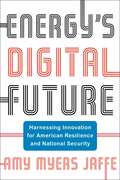- Table View
- List View
Energy and Sustainable Aviation Fuels Solutions: Proceedings of the International Symposium on Sustainable Aviation 2023 (Sustainable Aviation)
by Alper Dalkiran Ali Haydar Ercan T. Hikmet Karakoç Shau-Shiun Jan Chih-Yung Wu Currao GaetanoSustainable aviation is a long-term strategy to provide innovative solutions to the aviation industry's challenges. The International Symposium on Sustainable Aviation is a multi-disciplinary symposium that presents research on sustainability-based issues and future trends in aviation from an economic, social, and environmental perspective. The conference provides a platform offering insights on a broad range of current topics in aviation, such as improving aircraft fuel efficiency, fostering the use of biofuels, minimizing environmental impact, mitigating GHG emissions, and reducing engine and airframe noise. ISEAS allows researchers, scientists, engineers, practitioners, policymakers, and students to exchange information, present new technologies, and developments. Also, discuss future direction, strategies, and priorities in aviation and sustainability.
Energy and Sustainable Futures: Proceedings of 2nd ICESF 2020 (Springer Proceedings in Energy)
by John Senior Iosif Mporas Pandelis Kourtessis Amin Al-Habaibeh Abhishek Asthana Vladimir VukovicThis open access book presents papers displayed in the 2nd International Conference on Energy and Sustainable Futures (ICESF 2020), co-organised by the University of Hertfordshire and the University Alliance DTA in Energy. The research included in this book covers a wide range of topics in the areas of energy and sustainability including:• ICT and control of energy;• conventional energy sources;• energy governance;• materials in energy research;• renewable energy; and• energy storage.The book offers a holistic view of topics related to energy and sustainability, making it of interest to experts in the field, from industry and academia.
Energy and Sustainable Futures: Proceedings of the 3rd ICESF, 2022 (Springer Proceedings in Energy)
by Amin Al-Habaibeh Abhishek Asthana Vladimir Vukovic Jonathan D. NixonThis is an open access book. This book contains research papers presented at the 3rd International Conference on Energy and Sustainable Futures (ICESF), which took place at Coventry University, UK, in 2022. The ICESF is an annual conference organised by the UK-based Doctorial Training Alliance (DTA) programme. It is a multidisciplinary conference focused on addressing the future challenges and opportunities for meeting global energy targets and sustainable development goals. The conference brought together academic researchers, industry experts and research students to showcase the latest innovations and research on a wide range of topics in the areas of energy and sustainability, including • renewable energy; • ICT and control; • computational fluid dynamics; • optimization; • conventional energy sources; • energy governance; • materials in energy research; • energy storage and • energy access.
Energy and Transport in Green Transition: Perspectives on Ecomodernity (Routledge Studies in Sustainability)
by Nina Witoszek Atle MidttunThis book breaks new ground in the studies of green transition. It frames the ongoing transformation in terms of a "battle of modernities" with the emerging vision of ecomodernity as the final destination. It also offers a systematic exploration of the potential for extensive transformation of carbon-intensive sectors – with a focus on energy and transport – towards a low or post-carbon economy. The book does so in a comparative perspective, by pointing to a diversity of techno-economic and institutional solutions in the mature Western economies, and in the rapidly growing East and developing South. The contributors highlight a broad spectrum of available alternatives as well as illuminate conflicting interests involved. They also demonstrate how solutions to the climate challenge require parallel technological and governance innovation. The book advocates a new, overarching vision and agenda of ecomodernity – based on a synergistic paradigm-shift in industry, politics and culture – to trigger and sustain the ecological innovation necessary to tip development in a green direction. This vision cannot be monolithic; rather, it should reflect the diverse interests and conditions of the global population. This book is aimed at researchers and postgraduate students of energy, transport, environmental and climate policies, as well as development, environment, innovation and sustainability.
Energy and the Ecological Economics of Sustainability: The Growing Threat Of Species Invasions
by John PeetEnergy and the Ecological Economics of Sustainability examines the roots of the present environmental crisis in the neoclassical economics upon which modern industrial society is based. The author explains that only when we view ourselves in the larger context of the global ecosystem and accept the physical limits to what is possible can sustainability be achieved.
Energy and the English Industrial Revolution
by E. A. WrigleyThe industrial revolution transformed the productive power of societies. It did so by vastly increasing the individual productivity, thus delivering whole populations from poverty. In this new account by one of the world's acknowledged authorities the central issue is not simply how the revolution began but still more why it did not quickly end. The answer lay in the use of a new source of energy. Pre-industrial societies had access only to very limited energy supplies. As long as mechanical energy came principally from human or animal muscle and heat energy from wood, the maximum attainable level of productivity was bound to be low. Exploitation of a new source of energy in the form of coal provided an escape route from the constraints of an organic economy but also brought novel dangers. Since this happened first in England, its experience has a special fascination, though other countries rapidly followed suit.
Energy and the Financial System
by Roger BoydThe modern financial system was developed to support the rapid economic growth that took off about 200 years ago with the phenomenal amounts of cheap energy made available through the exploitation of fossil fuels. As a result, its viability is completely dependent upon the continuation of that growth. Unfortunately, the more recent fossil fuel discoveries, especially for oil, have tended to have lower production levels than earlier ones. In addition, greater amounts of energy are required to extract the fossil fuels leading to less net energy available for society. The Energy Return On Investment (EROI) for oil has fallen from 30:1 in the 1970's to 10:1 today. Thus, newer energy finds produce lower extraction rates and more of the energy provided is offset by the energy used in the extraction processes. The result has been economic stagnation or even contraction, with growth in China and India etc. only possible due to the extensive use of local coal reserves, and recession-induced drops in OECD country energy use. Renewable sources of energy will not be able to expand fast enough to replace the 87% of energy supplies provided by fossil fuels, and apart from hydro and wind, tend to have very low EROI rates. They are also critically dependent upon the cheap energy infrastructure provided by fossil fuels. The phenomenal amounts of path-dependent energy infrastructure will also greatly inhibit any move away from fossil fuels. Without continued economic growth there will not be the extra output to fund loan interest payments, nor the revenue and profit growth to support share price/earnings multiples. The financial system acts as a time machine, creating asset prices based upon perceptions of the future. As an increasing percentage of investors come to accept the future reality of at best, financial asset prices will fall to reflect a realistic future. The resulting crash will remove the underpinnings of the banking, brokerage, mutual fund, pension fund, and insurance industries. The comfortable futures of many will be shown to have been based upon a mirage of future growth that will not take place. With the financial system acting as the critical coordination system of the global economy, its crash will also intensify economic problems. Written by a retired financial industry executive with over 25 years of experience, this book describes how the crisis will affect different regions and industries to help identify the career and investment choices which may provide a relative safe harbour.
Energy and the Wealth of Nations
by Charles A. Hall Kent A. KlitgaardFor the past 150 years, economics has been treated as a social science in which economies are modeled as a circular flow of income between producers and consumers. In this "perpetual motion" of interactions between firms that produce and households that consume, little or no accounting is given of the flow of energy and materials from the environment and back again. In the standard economic model, energy and matter are completely recycled in these transactions, and economic activity is seemingly exempt from the Second Law of Thermodynamics. As we enter the second half of the age of oil, and as energy supplies and the environmental impacts of energy production and consumption become major issues on the world stage, this exemption appears illusory at best. In Energy and the Wealth of Nations, concepts such as energy return on investment (EROI) provide powerful insights into the real balance sheets that drive our "petroleum economy." Hall and Klitgaard explore the relation between energy and the wealth explosion of the 20th century, the failure of markets to recognize or efficiently allocate diminishing resources, the economic consequences of peak oil, the EROI for finding and exploiting new oil fields, and whether alternative energy technologies such as wind and solar power meet the minimum EROI requirements needed to run our society as we know it. This book is an essential read for all scientists and economists who have recognized the urgent need for a more scientific, unified approach to economics in an energy-constrained world, and serves as an ideal teaching text for the growing number of courses, such as the authors' own, on the role of energy in society.
Energy and the Wealth of Nations: Understanding The Biophysical Economy
by Charles A.S. Hall Kent KlitgaardIn this updated edition of a groundbreaking text, concepts such as energy return on investment (EROI) provide powerful insights into the real balance sheets that drive our “petroleum economy.” Hall and Klitgaard explore the relation between energy and the wealth explosion of the 20th century, and the interaction of internal limits to growth found in the investment process and rising inequality with the biophysical limits posed by finite energy resources. The authors focus attention on the failure of markets to recognize or efficiently allocate diminishing resources, the economic consequences of peak oil, the high cost and relatively low EROI of finding and exploiting new oil fields, including the much ballyhooed shale plays and oil sands, and whether alternative energy technologies such as wind and solar power can meet the minimum EROI requirements needed to run society as we know it.For the past 150 years, economics has been treated as a social science in which economies are modeled as a circular flow of income between producers and consumers. In this “perpetual motion” of interactions between firms that produce and households that consume, little or no accounting is given of the flow of energy and materials from the environment and back again. In the standard economic model, energy and matter are completely recycled in these transactions, and economic activity is seemingly exempt from the Second Law of Thermodynamics. As we enter the second half of the age of oil, when energy supplies and the environmental impacts of energy production and consumption are likely to constrain economic growth, this exemption should be considered illusory at best. This book is an essential read for all scientists and economists who have recognized the urgent need for a more scientific, empirical, and unified approach to economics in an energy-constrained world, and serves as an ideal teaching text for the growing number of courses, such as the authors’ own, on the role of energy in society.
Energy as a Sociotechnical Problem: An Interdisciplinary Perspective on Control, Change, and Action in Energy Transitions (Routledge Studies in Energy Transitions)
by Christian Büscher Patrick Sumpf Jens SchipplEnergy as a Sociotechnical Problem offers an innovative approach to equip interdisciplinary research on sociotechnical transitions with coherence and focus. The book emphasizes sociotechnical problems in three analytical dimensions: - In the control dimension, contributing authors examine how control can be maintained despite increasing complexity and uncertainty, e.g., in power grid operations or on energy markets; - In the change dimension, the authors explore if and how change is possible despite the need for stable orientation, e.g., regarding discourses, real-world labs and learning; - Finally, in the action dimension, the authors analyze how the ability to act on a permanent basis is sustained despite opaqueness and ignorance, exemplified by the work on trust, capabilities or individual motives. Drawing on contributions from engineering, economics, philosophy, political science, psychology and sociology, the book assembles a range of classic and current themes including innovation, resilience, institutional economics, design or education. Energy as a Sociotechnical Problem presents the ongoing transformation of the energy complex as a multidimensional process, in which the analytical dimensions interact with each other in shaping the energy future. As such, this book will be of great interest to students and scholars of energy transitions, energy science and environmental social science more generally, as well as to practitioners working within the field of energy policy.
Energy for Development: Resources, Technologies, Environment
by Ferenc L. TothThis collection of contributions from a diverse group of prominent international scientists and policy makers brings together their in-depth analyses and innovative ideas about how to resolve the 'energy for development' predicament. It includes studies quantifying the role of energy in socioeconomic development, analysis of the interplay between supranational and national institutions in policy implementation, the energy implications of demographic trends such as urbanisation, and exploration of supply-side issues such as the potential role of nuclear energy and 'cleaning' fossil fuel energy generation through carbon capture.
Energy for the 21st Century: A Comprehensive Guide to Conventional and Alternative Sources
by Roy NersesianA compendium of current knowledge about conventional and alternative sources of energy. It clarifies complex technical issues, enlivens history, and illuminates the policy dilemmas we face today. This revised edition includes new material on biofuels, an expanded section on sustainability and sustainable energy, and updated figures and tables throughout. There are also online instructor materials for those professors who adopt the book for classroom use.
Energy from Microalgae (Green Energy And Technology)
by Eduardo Jacob-Lopes Leila Queiroz Zepka Maria Isabel QueirozThis book presents an authoritative and comprehensive overview of the production and use of microalgal biomass and bioproducts for energy generation. It also offers extensive information on engineering approaches to energy production, such as process integration and process intensification in harnessing energy from microalgae. Issues related to the environment, food, chemicals and energy supply pose serious threats to nations’ success and stability. The challenge to provide for a rapidly growing global population has made it imperative to find new technological routes to increase the production of consumables while also bearing in mind the biosphere’s ability to regenerate resources. Microbial biomass is a bioresource that provides effective solutions to these challenges.Divided into eight parts, the book explores microalgal production systems, life cycle assessment and the bio-economy of biofuels from microalgae, process integration and process intensification applied to microalgal biofuels production. In addition, it discusses the main fuel products obtained from microalgae, summarizing a range of useful energy products derived from algae-based systems, and outlines future developments. Given the book’s breadth of coverage and extensive bibliography, it offers an essential resource for researchers and industry professionals working in renewable energy.
Energy from the Desert: Feasibility of Very Large Scale Photvoltaic Power Generation Systems & Practical Proposals for Very Large Scale Photovoltaic Systems
by Keiichi Komoto David Faiman Masakazu Ito Peter van der Vleuten Kosuke KurokawaThe world's deserts are sufficiently large that, in theory, covering a fraction of their landmass with PV systems could generate many times the current primary global energy supply. The Energy from the Desert two-volume set details the background and concept of Very Large Scale Photovoltaics (VLS-PC) and examines and evaluates their potential as viable power generation systems. The authors present case studies of both virtual and real projects based on selected regions (including the Mediterranean, Sahara, Chinese Gobi, Mongolian Gobi, Indian Thar, Australian Desert and the US) and their specific socio-economic dynamics, and argue that VLS-PV systems in desert areas will be readily achievable in the near future.
Energy in Africa: Challenges And Opportunities (SpringerBriefs in Energy)
by Simone Tagliapietra Manfred Hafner Lucia De StrasserThis open access book presents a picture of the current energy challenges on the African continent (and the Sub-Saharan region in particular) and proposes pathways to an accelerated energy transition. Starting with an analysis of the status quo and the outlook for Africa’s energy demand and energy access, it provides an account of the available resources, including hydrocarbons and renewable energy resources, which are playing an increasingly crucial role. It then moves on to analyze the level of investment required to scale-up Africa’s energy systems, shedding light on the key barriers and elaborating on potential solutions. It also provides a suggestion for improving the effectiveness of EU–Africa cooperation. While mainly intended for policymakers and academics, this book also speaks to a broader audience interested in gaining an overview of the challenges and opportunities of the African energy sector today and in the future.
Energy in Africa: Policy, Management and Sustainability
by Sola Adesola Feargal BrennanBringing together conceptual, theoretical and evidence-based contributions from a diverse set of experts, this book provides a comprehensive analysis of energy in Africa, from a management perspective. Taking a closer look at the global energy environment and security in developing areas of the region, the authors discuss the significance of energy policy to the socio-economic growth of the continent. This important book tackles the challenge of ensuring sustainability in Africa and focuses on both fossil fuels and renewable energy. Essential reading for researchers interested in energy management, sustainability, and energy policy, this noteworthy collection of interdisciplinary contributions provides examples of effective energy management in Africa.
Energy in America's Future: The Choices Before Us (RFF Energy Policy Set)
by Joel Darmstadter Sam H. Schurr Harry Perry William C. Ramsay Milton RussellResults of a comprehensive two-year study analyzing the facts and policy alternatives. Originally published in 1979.
Energy in Australia
by Graham PalmerWith rapidly declining costs and seemingly unlimited sunshine, the choice of solar in Australia seems obvious. Yet despite its many advantages, homes with solar remain completely dependent on the electricity grid for reliable supply, which in Australia implies mostly coal-fired generation. Indeed, even countries that have invested heavily in solar, such as Spain and Germany, have been unable to deflect the trajectory of fossil fuel dependence. The reasons for this apparent paradox are varied, and this book provides a deeper and more nuanced understanding of the practical applications of photovoltaics (PV) in modern electricity systems. While the conventional life-cycle assessment (LCA) boundaries as prescribed by the IEA-PVPS provide a consistent methodology for comparing evolving PV technologies, the narrow boundaries exclude many critical downstream energy costs. Similarly, simple cost comparisons of PV versus conventional power sources overlook the significant economic and energy costs of intermittency and grid integration. Yet distributed storage, which could provide potentially valuable network support, is frequently given a low priority by advocates of solar. Treating PV as an extension of, rather than as a substitute for, the fossil fuel enterprise enables a more productive discussion of PV's potential role in electricity generation. The sunburnt country of Australia, which has a modern electricity system, is an ideal case study for exploring the potential of solar PV. With a focus on rooftop solar, energy storage, grid integration, and electricity system issues, Energy in Australia offers valuable insights into the practical challenges of solar power. Although many national economies are already confronting a downward trend in energy return on investment (EROI) of oil and gas from both conventional and unconventional sources, the large-scale deployment of low-emission energy sources that lie below a critical minimum EROI threshold may ultimately prove counter-productive.
Energy in Brazil: Towards a Renewable Energy Dominated System
by Antonio Dias LeiteRapidly developing countries such as China and India are the real main players in the climate debate, with the potential for massive increases in their carbon emissions in coming years. Brazil is often included in their number, yet this country is in fact notable for its exceptionally high reliance on energy from renewable sources - approaching 50%. However, the fact that much of this energy comes from hydropower and biofuels, and recent discoveries of massive oil reserves off of the Brazilian coast, are a recipe for controversy. In this detailed account, Antonio Dias Leite sets out the development of Brazil's energy mix. Beginning with the history of energy provision and use, he then moves on to tackle the various sources in detail: hydropower, biomass and other renewables, as well as fossil fuels and nuclear power. In each case he examines growth, distribution, environmental and socio-economic issues (such as deforestation and displacement of indigenous communities) and potential for future development - highlighting what has worked, and what hasn't. The book ends by examining Brazilian approaches to energy efficiency, and by positioning Brazil in the world context. This is a major contribution to the discussion around climate change mitigation that will be key reading for policymakers and researchers concerned with the future role and impacts of rapidly developing countries.
Energy in China's Modernization
by Vaclav SmilA selection of 50 Slovak folk tales assembled from the collections of folklorist Pavol Dobsinsky. The translator seeks to preserve the poetic qualities of the originals, and the book includes an introduction to the genres of the folktale and the specifics of Slovak tales.
Energy in Europe: Issues and Policies (Routledge Library Editions: Energy)
by Thomas G. Weyman-JonesOriginally published in 1986. Energy economics emerged in the 1970s as one of the most controversial and critical aspects of European economic and political development. This book provides a fully comprehensive but easily accessible guide to the key issues of energy policy, placing them in a European context. As well as discussing oil price movements and their effects on European prosperity, it assesses the role of energy conservation and pricing policies. The chapters discuss the economic, political and social impact of nuclear power programmes, North Sea oil and gas discoveries, Soviet gas imports, and coal field closures, and go on to forecast possible future developments. This is for all those concerned with European and energy studies, especially political scientists, geographers, economists, and environmental and resource specialists.
Energy in Perspective
by Mark CronshawThis textbook provides broad coverage of energy supply and use. It discusses how energy is produced, transformed, delivered to end users, and consumed. The author discusses all of this at an undergraduate level, accessible to students of varying backgrounds. High-level and human-scale perspectives are included. As a high-level example, the book discusses the shares of global primary energy that are provided by oil, gas, coal, hydroelectricity, and renewables, as well as trends in energy consumption and supply over time. Human-scale examples will resonate with readers’ every day experiences. The link between economic development and energy consumption is presented, which facilitates understanding of how global energy consumption growth is inevitable as economic development occurs. Coverage includes separate chapters on the oil, natural gas, coal, and electricity sectors. Each of these provides high-level descriptions of the technology involved in the production of that type of energy as well as the processing and transportation that occurs to bring the energy to end users. The book discusses the technological implications of energy transitions such as increased use of renewables or changes in the use of nuclear energy using Germany and Japan as examples. It closes with a discussion of future energy use.
Energy in the Nordic World (Nordic World)
by Mogens Rüdiger Anna ÅbergNorway and Sweden are among the biggest consumers of energy per capita, yet the Nordic nations also lead the world in clean power production and have ambitious goals of decarbonizing their energy systems by 2050. Denmark, Norway, Sweden, Finland, and Iceland vary drastically in geography and the availability of natural resources, but each consistently generates electricity from renewable sources at multiple times the average rate of other high-income countries. Mogens Rüdiger and Anna Åberg present a concise and timely history of energy production, trade, and consumption in Norden, starting with a review of the regional energy mix—from wind, solar, tide and wave, geothermal, biomass, nuclear, coal, and gas sources. Brief chapters describe the diversity of Nordic energy markets, assess how far the green transition has come, and explore what comes next as global crises, domestic politics, and technological developments present novel challenges and opportunities. Energy infrastructures and economic activities, Rüdiger and Åberg argue, serve as unique cultural focal points in the region. The coauthors summarize the national policy frameworks for the sector as well as the key energy and economic indicators used in infrastructure planning, regulation, and the opening of the electricity and gas markets to free competition. Energy in the Nordic World is the essential primer to the power markets at the heart of Europe’s energy transition.
Energy of the Russian Arctic: Ideals and Realities
by Valery I. SalyginThis volume is an energy-tailored sequel to the research on the Arctic carried out at MGIMO University. Specifically, the proposed book is grounded in the profound academic and practical expertise of the specialized body of MGIMO University – International Institute of Energy Policy and Diplomacy chaired by Prof. Valery Salygin. Thus, the research exclusively focuses on energy-related aspects of exploration of the Arctic Zone of the Russian Federation (AZRF). This particular region with its ample oil and gas resources has been comparatively and critically studied by a team of authors representing Russia, USA, France, Switzerland, Slovakia, and Lithuania from legislative, political, economic, technical, transport, environmental, sustainability, and security perspectives.
Energy's Digital Future: Harnessing Innovation for American Resilience and National Security (Center on Global Energy Policy Series)
by Amy Myers JaffeDisruptive digital technologies are poised to reshape world energy markets. A new wave of industrial innovation, driven by the convergence of automation, artificial intelligence, and big data analytics, is remaking energy and transportation systems in ways that could someday end the age of oil. What are the consequences—not only for the environment and for daily life but also for geopolitics and the international order?Amy Myers Jaffe provides an expert look at the promises and challenges of the future of energy, highlighting what the United States needs to do to maintain its global influence in a post-oil era. She surveys new advances coming to market in on-demand travel services, automation, logistics, energy storage, artificial intelligence, and 3-D printing and explores how this rapid pace of innovation is altering international security dynamics in fundamental ways. As the United States vacillates politically about its energy trajectory, China is proactively striving to become the global frontrunner in a full-scale global energy transformation. In order to maintain its leadership role, Jaffe argues, the United States must embrace the digital revolution and foster American achievement. Bringing together analyses of technological innovation, energy policy, and geopolitics, Energy’s Digital Future gives indispensable insight into the path the United States will need to pursue to ensure its lasting economic competitiveness and national security in a new energy age.
